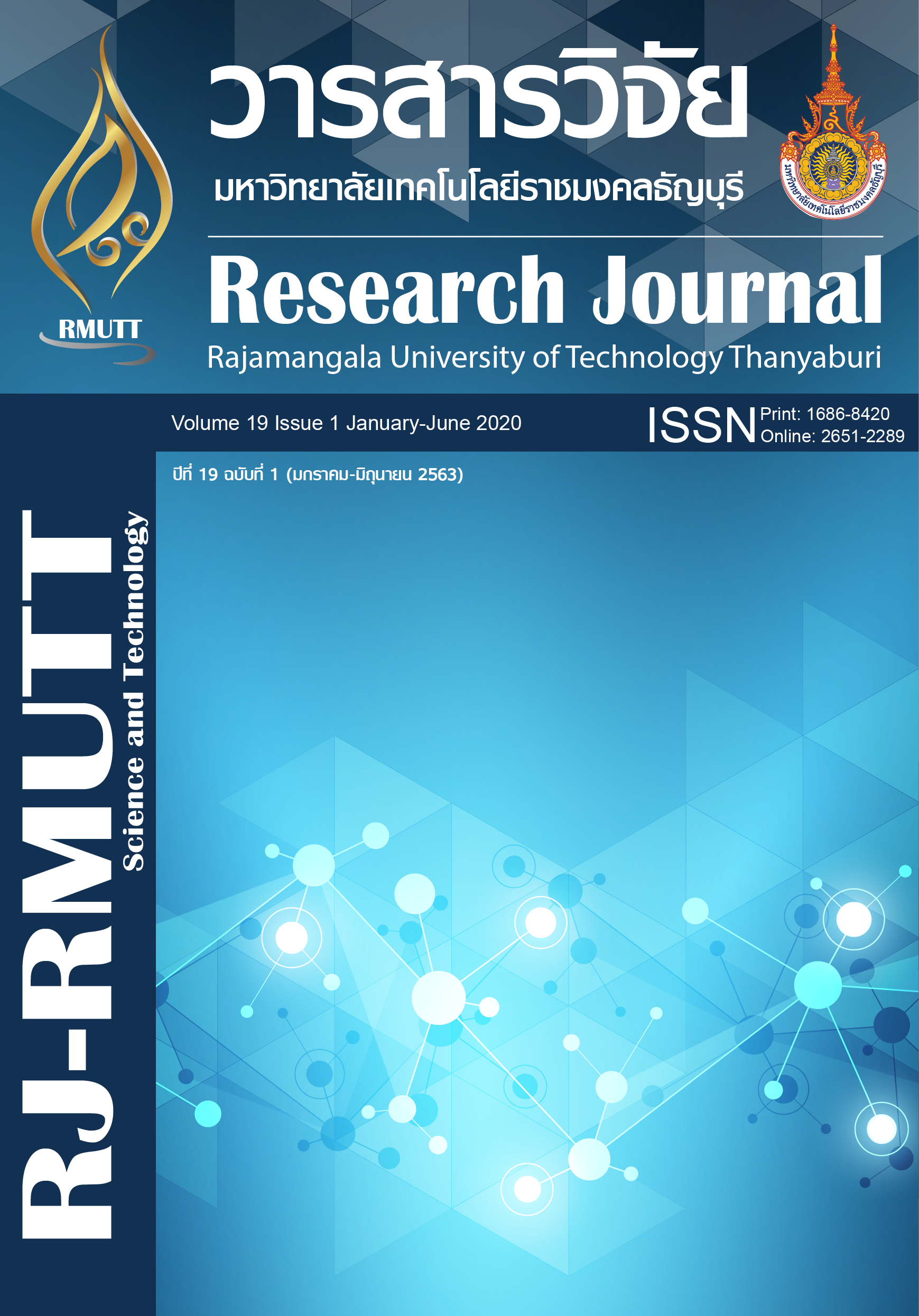Preparation of Polymer Microcapsules Encapsulated Fragrance by Pickering Emulsion Technique
Main Article Content
Abstract
In this research, the preparation of polymethyl methacrylate-co-ethylene glycol dimethacrylate) (PMMA-co-EGDMA)) microcapsules encapsulated methyl anthranilate as a fragrance model by microsuspension polymerization was studied. The monomer droplets were prepared by pickering emulsion method using zinc oxide nanoparticles as a particulate stabilizer. The ratios of monomers: MA, MMA: EGDMA and initiator concentration were investigated. From the experimental result, it was found that using monomers: methyl anthranilate of 70: 30, MMA: EGDMA of 50: 50 and initiator concentration of 8 wt% of monomers was an optimum condition for the preparation of microcapsule. The high colloidal stable spherical microcapsules were prepared without the formation of free polymer particles in an aqueous medium. The rough surface microcapsules due to the presence of zinc oxide nanoparticles as a particulate stabilizer distributed on microcapsule surface were successfully prepared. The encapsulation efficiency of methyl anthranilate in microcapsules was high up to approximately 100 %. When such optimum condition was applied for the encapsulation of commercial fragrance, the stable microcapsules with high encapsulation efficiency were obtained as well.
Article Details

This work is licensed under a Creative Commons Attribution-NonCommercial-NoDerivatives 4.0 International License.
References
Hyldgaard M, Mygind T, Meyer R. Essential oils in food preservation: mode of action, synergies, and interactions with food matrix components. Front Microbiol. 2012;3:36-59.
Pavithra PS, Mehta A, Verma RS. Essential oils: from prevention to treatment of skin cancer. Drug Discov Today. 2019;24(2):644-55.
Kaur R, Kukkar D, Bhardwaj SK, Kim K-H, Deep A. Potential use of polymers and their complexes as media for storage and delivery of fragrances. J Control Release. 2018;285:81-95.
Pansuwan J, Chaiyasat A. Innovative and high performance synthesis of microcapsules containing methyl anthranilate by microsuspension iodine transfer polymerization. Polym Int. 2017;66(12):1921-27.
Chaiyasat P, Islam MZ, Chaiyasat A. Preparation of poly(divinylbenzene) microencapsulated octadecane by microsuspension polymerization: oil droplets generated by phase inversion emulsification. RSC Adv. 2013;3(26):10202-7.
Ramsden W, Gotch F. Separation of solids in the surface-layers of solutions and ‘suspensions’ (observations on surface-membranes, bubbles, emulsions, and mechanical coagulation).—Preliminary account. Proc Roy Soc Lond. 1904;72:156-64.
Pickering SU. CXCVI.—Emulsions. J Chem Soc Trans. 1907;91:2001-21.
Yang Y, Fang Z, Chen X, Zhang W, Xie Y, Chen Y, et al. An Overview of Pickering Emulsions: Solid-Particle Materials, Classification, Morphology, and Applications. Front Pharmacol. 2017;8:179-98.
Chevalier Y, Bolzinger MA. Emulsions stabilized with solid nanoparticles: Pickering emulsions. Colloids Surf A Physicochem Eng Aspects. 2013;439:23-34.
Ma H, Luo M, Sanyal S, Rege K, Dai LL. The One-Step Pickering Emulsion Polymerization Route for Synthesizing Organic-Inorganic Nanocomposite Particles. Materials. 2010;3(2):1186-202.
Binks BP. Particles as surfactants—similarities and differences. Curr Opin Colloid Interface Sci. 2002;7(1):21-41.
Zhu F. Starch based Pickering emulsions: Fabrication, properties, and applications. Trends Food Sci Technol. 2019;85:129-37.
Li Q, Zhao T, Li M, Li W, Yang B, Qin D, et al. One-step construction of Pickering emulsion via commercial TiO2nanoparticles for photocatalytic dye degradation. Appl Catal B Environ. 2019;249:1-8.
Demina PA, Grigoriev DO, Kuz’micheva GM, Bukreeva TV. Preparation of pickering-emulsion-based capsules with shells composed of titanium dioxide nanoparticles and polyelectrolyte layers. Colloid J. 2017;79(2):198-203.
Marto J, Gouveia LF, Gonçalves L, Chiari-Andréo BG, Isaac V, Pinto P, et al. Design of novel starch-based Pickering emulsions as platforms for skin photoprotection. J Photochem Photobiol B Biol. 2016;162:56-64.
Zhang K, Wu W, Guo K, Chen JF, Zhang PY. Magnetic polymer enhanced hybrid capsules prepared from a novel Pickering emulsion polymerization and their application in controlled drug release. Colloids Surf A Physicochem Eng Aspects. 2009;349(1):110-6.
Shah BR, Li Y, Jin W, An Y, He L, Li Z, et al. Preparation and optimization of Pickering emulsion stabilized by chitosan-tripolyphosphate nanoparticles for curcumin encapsulation. Food Hydrocoll. 2016;52:369-77.
Siddiqi KS, Ur Rahman A, Tajuddin, Husen A. Properties of Zinc Oxide Nanoparticles and Their Activity Against Microbes. Nanoscale Res Lett. 2018;13(1):141-53.
Sirelkhatim A, Mahmud S, Seeni A, Kaus NHM, Ann LC, Bakhori SKM, et al. Review on Zinc Oxide Nanoparticles: Antibacterial Activity and Toxicity Mechanism. Nano-Micro Lett. 2015;7(3):219-42.
Hu X, Cook S, Wang P, Hwang H-m. In vitro evaluation of cytotoxicity of engineered metal oxide nanoparticles. Sci Total Environ. 2009;407(8):3070-2.
Salem W, Leitner DR, Zingl FG, Schratter G, Prassl R, Goessler W, et al. Antibacterial activity of silver and zinc nanoparticles against Vibrio cholerae and enterotoxic Escherichia coli. Int J Med Microbiol. 2015;305(1):85-95.
Premanathan M, Karthikeyan K, Jeyasubramanian K, Manivannan G. Selective toxicity of ZnO nanoparticles toward Gram-positive bacteria and cancer cells by apoptosis through lipid peroxidation.Nanomed Nanotechnol. 2011;7(2):184-92.
Pati R, Mehta RK, Mohanty S, Padhi A, Sengupta M, Vaseeharan B, et al. Topical application of zinc oxide nanoparticles reduces bacterial skin infection in mice and exhibits antibacterial activity by inducing oxidative stress response and cell membrane disintegration in macrophages. Nanomed Nanotechnol. 2014;10(6):1195-208.
Chaiyasat P, Chaiyasat A, Boontung W, Promdsorn S, Thipsit S. Preparation and Characterization of Poly(divinylbenzene) Microcapsules Containing Octadecane. Mater Sci Appl. 2011;2(8):1007-13.
Supatimusro D, Promdsorn S, Thipsit S, Boontung W, Chaiyasat P, Chaiyasat A. Poly(divinylbenzene) Microencapsulated Octadecane for Use as a Heat Storage Material: Influences of Microcapsule Size and Monomer/Octadecane Ratio. Polym Plast Technol Eng. 2012;51(11):1167-72.


